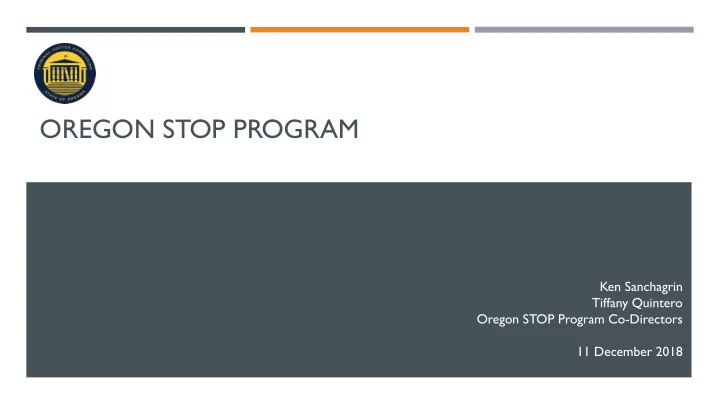

OREGON STOP PROGRAM Ken Sanchagrin Tiffany Quintero Oregon STOP Program Co-Directors 11 December 2018
OREGON STOP PROGRAM BACKGROUND HB 2355 (2017) had two primary components: It required the collection of traffic and pedestrian stop data from all Oregon law enforcement by 2021. It changed Oregon’s drug possession laws. The Statistical Transparency Of Policing (STOP) Program was created to implement the requirements of HB 2355 for traffic/pedestrian stop data collection. STOP has been a collaborative effort between CJC, OSP, and DPSST. The STOP Program developed the technological means for LEAs to report data as required by HB 2355 and provides assistance to LEAs in meeting their reporting requirements. Starting in December 2019, the CJC will submit an annual report to the Legislature analyzing STOP data. LEAs identified as having potential disparities will be offered training and technical assistance from DPSST.
STOP DATA COLLECTION WHAT DATA WILL BE COLLECTED?
STOP DATA COLLECTION STOP STAKEHOLDER ENGAGEMENT GROUP To assist with the implementation of HB2355, the STOP Stakeholder Group was formed, consisting of representatives from OSP, CJC, and DPSST, as well as representatives from: Law Enforcement Legislature Department of Justice Office of the State CIO Community Groups and the ACLU The goal of the Stakeholder Engagement group was to implement HB2355 in a manner that would ensure efficient and effective collection of high quality data
STOP DATA COLLECTION STAKEHOLDER DEFINED VARIABLES Stop Variables Demographic Variables Geographic Variables Law Enforcement Agency Id Geocode Data (X,Y) Type of Stop Full Street Address Stop Date and Time Perceived Age City, State, Zip Justification for the Stop Perceived Gender County where Stop Occurred Was a Search Conducted? Perceived Race/Ethnicity Highway and Milepost Search Type Residential Zip Code Landmark Search Findings Intersection Location Disposition of the Stop
STOP DATA COLLECTION THREE TIERED ROLLOUT Tier 1: 100+ Officers Tier 2: 25-99 Officers Tier 3: 1-24 Officers Beaverton PD Approximately 40 Agencies, including, Approximately 100 Agencies, including, Clackamas County Sheriff Ashland PD Astoria PD Eugene PD Bend PD Coos County Sheriff Gresham PD Benton County Sheriff John Day PD Hillsboro PD Clatsop County Sheriff Newport PD Marion County Sheriff Hood River County Sheriff Portland State University PD Medford PD Lake Oswego PD Seaside PD Multnomah County Sheriff McMinnville PD Silverton PD Oregon State Police Oregon City PD Sunriver PD Portland Police Bureau Tigard PD The Dalles PD Salem PD Yamhill County Sheriff Wasco County Sheriff Washington County Sheriff
OREGON STOP PROGRAM DATA SUBMISSION OPTIONS
STOP DATA COLLECTION HOW WILL DATA BE ANALYZED?
STOP DATA ANALYSIS BACKGROUND AND CHALLENGES Various types of traffic stop data have been collected and analyzed for 30 years. No statistical method can prove discrimination — they can only identify instances that indicate the possible presence of discrimination. Primary Issues for Research: The benchmark problem: How can we select the appropriate baseline for comparison? Traffic stop data shows us the share of drivers from demographic groups stopped by law enforcement Researchers need to determine the appropriate pool of at risk drivers for comparisons Alternative Explanation Problem. Disparities in stop data could be due to: Racially biased policing Differences in driving behavior and/or offending rates Differences in exposure to law enforcement
STOP DATA ANALYSIS ADDRESSING RESEARCH CHALLENGES How can the CJC address these shortcomings and Initial Decision to challenges? Stop a Driver or First, police-citizen encounters must be broken down Pedestrian into their component parts. Is there a disparity in the initial decision to stop a driver or pedestrian? Are there disparities in post-stop decisions, such as whether an individual is searched, cited, or arrested? Post-Stop Outcomes: Second, statistical models capable of addressing as Searches, many of the identified challenges as possible must be Warnings, used. Citations, or In the end, however, we must remember that we Arrests cannot prove discrimination or explain why disparities occur.
Questions? Ken Sanchagrin STOP Program Co-Director 503-373-7449 ken.sanchagrin@oregon.gov Tiffany Quintero STOP Program Co-Director 503-991-3290 tiffany.quintero@oregon.gov
Recommend
More recommend